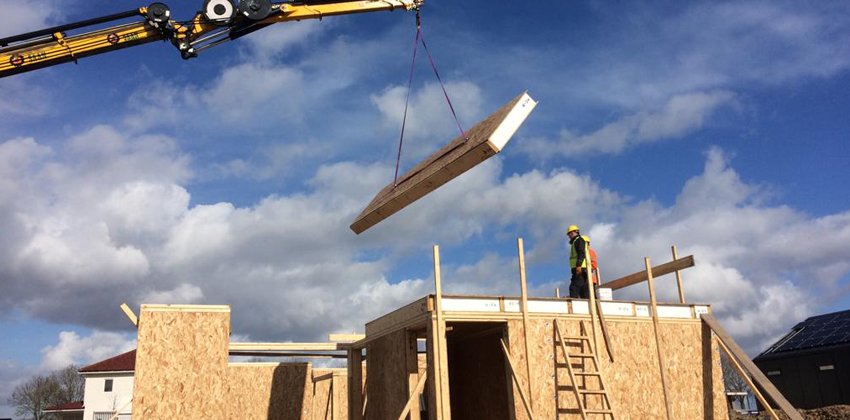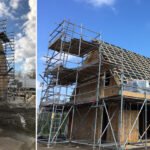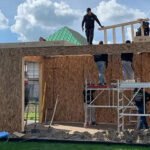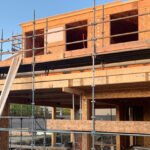
From Panel to Home: How SIPs Work in Practice
Structural Insulated Panels (SIPs) are often described as “the future of construction,” but what does that actually mean on the jobsite? For many developers and homeowners, the idea of building a house from prefabricated panels may sound abstract. The reality, however, is straightforward: SIPs make the building process faster, simpler, and more predictable than traditional methods.
This blog walks step by step through how SIPs move from factory production to a finished home, showing exactly why they are one of the most practical innovations in modern construction.
Step 1: Prefabrication in the Factory
The journey begins long before the panels reach the construction site.
- Material Selection: Quacent SIPs use high-quality OSB4 facings and Neopor® insulation cores.
- Lamination: Panels are bonded under pressure with structural adhesives, ensuring strength and durability.
- CNC Precision: Openings for windows, doors, and service chases are cut with millimeter accuracy.
- Packaging: Panels are organized by building phase and shipped as Ready-To-Assemble (RTA) kits.
This factory-controlled process ensures every panel arrives ready to perform, eliminating many of the delays and errors common with on-site construction.
Step 2: Transport and Delivery
Once manufactured, panels are flat-packed into containers for efficient shipping.
- Containerized Logistics: Reduces transport costs and protects panels.
- Customs and Compliance: All required documents are prepared in advance for EU entry.
- Just-in-Time Delivery: Panels arrive when foundations are complete, minimizing the need for on-site storage.
By streamlining logistics, SIPs fit seamlessly into both small local projects and international developments.
Step 3: Assembly on Site
This is where the transformation begins:
- Foundations Ready: With a level and accurate foundation, panels can be assembled like a giant puzzle.
- Rapid Progress: Walls and roofs go up in days, not months. A single-family home can be weather-tight in under a week.
- Small Crews: Typically, 4–6 workers are enough to assemble a SIP shell.
- Supervised Installation: Quacent provides training and on-site supervisors for first-time contractors.
The speed and simplicity of SIP assembly astonish many clients, who expect months of construction but see walls rising within hours.
Step 4: Weatherproofing and Finishing
Once the SIP shell is up, the project moves quickly into finishing stages:
- Exterior Cladding: Brick, timber, render, or composite facades can be applied.
- Roof Coverings: Tiles, shingles, or metal roofs complete the envelope.
- Interior Finishes: SIPs provide smooth surfaces for plasterboard or other finishes.
- Service Integration: Pre-cut chases simplify electrical and plumbing installations.
Because SIPs provide structure, insulation, and airtightness in one step, the building is ready for finishing much earlier than in traditional projects.
Benefits for Contractors
From a contractor’s perspective, the panel-to-home process offers clear advantages:
- Reduced Labor Needs: Smaller teams can deliver large results.
- Predictable Timelines: Prefabrication eliminates weather delays and sequencing conflicts.
- Simplified Training: Crews can be trained quickly to handle SIP installations.
- Profitability: Faster turnover means more projects per year.
SIPs not only simplify construction—they make contracting more competitive and profitable.
Benefits for Homeowners
For homeowners, seeing SIPs turn into a finished home provides confidence and peace of mind:
- Faster Delivery: Families move in months earlier than with traditional methods.
- Lower Bills: Airtightness and insulation deliver long-term energy savings.
- Durability: Homes resist mold, pests, and structural settlement.
- Modern Comfort: Excellent acoustics and stable indoor climates enhance daily life.
SIPs turn the dream of a modern, efficient, and comfortable home into reality faster than expected.
Common Misconceptions
- “It’s Just Panels”: SIPs are not flat-pack compromises—they are high-performance building systems.
- “It Must Be Complicated”: In practice, SIP assembly is intuitive and supported by clear instructions.
- “Prefab Means Low Quality”: Factory precision ensures higher consistency than many traditional builds.
Once contractors and clients experience SIP construction firsthand, these misconceptions quickly disappear.
Looking Ahead
The panel-to-home process is part of a larger shift toward industrialized construction in Europe. Expect to see:
- More Modular Integration: SIPs combined with prefabricated modules for hybrid solutions.
- Circular Practices: Panels designed for reuse or recycling at end of life.
- Digital Workflows: BIM models linked directly to CNC cutting for perfect accuracy.
- Wider Adoption: From private homes to schools, offices, and public housing.
SIPs are proving that industrialized building methods can be both efficient and high-quality.
Conclusion
From factory production to on-site assembly, SIPs transform construction into a faster, simpler, and more predictable process. They provide a complete solution: structure, insulation, and airtightness in one panel.
For contractors, this means efficiency and profitability. For homeowners, it means comfort, sustainability, and affordability. For policymakers, it represents a scalable solution to Europe’s housing crisis.
From panel to home, SIPs demonstrate that the future of construction is already here.





Add a comment